| Back to Back Issues Page |
 |
|
Dallying In The Dirt, Issue #120 --- We leave some winter grasses when doing the fall cleanup. December 02, 2012 |
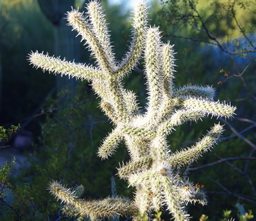
You didn’t get any pictures with the last issue of Dallying In The Dirt because I was rushing to catch a plane. Had a wonderful time playing with two granddaughters in the North of England. It was sunny and bright most of the time but rather frosty in the mornings. Gardening is so much more intense over there and they utilize every possible space to grow things that I cannot. Not that I’m envious. The lack of pictures means you didn’t get to appreciate the desert flora from my visit to Tucson. I now have a whole page about the Tucson Botanical garden where you can go and get a sense of the diversity of succulents that thrive there. 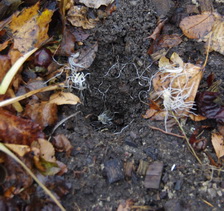 The vast army of bushy tailed tree rats, (AKA squirrels,) that inhabit the garden are making themselves even more unwelcome this fall. They did help out by eating most of the walnuts and thereby saving me the effort of picking them up. With the walnuts all gone they seem to focussing on the 650+ tulips that I spent days planting. At first I thought they were just getting the more shallowly planted Crocus but it now appears that they are digging deeper. The layer of Acti-Sol, a chicken manure based fertilizer that usually repels squirrels, does not seem to have been as effective this year and I have just added a new layer of it. I’m worried that all of my planting efforts will not yield the desired blast of spring colour. I’m also worried that the ravenous appetite of this year’s squirrels is an indicator of how severe the winter might be.
The vast army of bushy tailed tree rats, (AKA squirrels,) that inhabit the garden are making themselves even more unwelcome this fall. They did help out by eating most of the walnuts and thereby saving me the effort of picking them up. With the walnuts all gone they seem to focussing on the 650+ tulips that I spent days planting. At first I thought they were just getting the more shallowly planted Crocus but it now appears that they are digging deeper. The layer of Acti-Sol, a chicken manure based fertilizer that usually repels squirrels, does not seem to have been as effective this year and I have just added a new layer of it. I’m worried that all of my planting efforts will not yield the desired blast of spring colour. I’m also worried that the ravenous appetite of this year’s squirrels is an indicator of how severe the winter might be.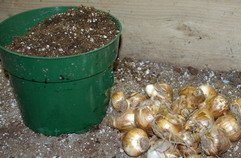 When it’s too nasty to venture outside, I descend to the basement and continue potting up the dwarf Narcissus that I will be forcing into bloom by late February. The need about 8 weeks in the cold room to overcome their dormancy. This year I also have a box of Paperwhites that will bloom in a couple of weeks after planting and do not require a cold period. Should have them in bloom well before Christmas. Of course there are the usual Amaryllis to be potted up or wrapped up as Christmas presents. The annual planting of those bulbs with the grandchildren is an event we all look forward to.
When it’s too nasty to venture outside, I descend to the basement and continue potting up the dwarf Narcissus that I will be forcing into bloom by late February. The need about 8 weeks in the cold room to overcome their dormancy. This year I also have a box of Paperwhites that will bloom in a couple of weeks after planting and do not require a cold period. Should have them in bloom well before Christmas. Of course there are the usual Amaryllis to be potted up or wrapped up as Christmas presents. The annual planting of those bulbs with the grandchildren is an event we all look forward to.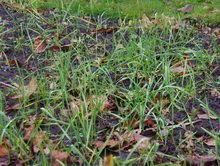 We are still eating from the vegetable garden. A few things such as Leeks and Brussel’s Sprouts actually improve in taste with a few light frosts. Other things such as Broccoli, Swiss Chard and Celery just keep on growing until a severe freeze knocks them down. I also have a few Pak Choi that I planted in late August, now yielding their lovely white crunchy stalks. The area that I worked so diligently digging out all of the random Garlic now looks like an fresh green lawn. Apparently I missed a lot of small garlic cloves that are now happily colonizing that bed once again.
We are still eating from the vegetable garden. A few things such as Leeks and Brussel’s Sprouts actually improve in taste with a few light frosts. Other things such as Broccoli, Swiss Chard and Celery just keep on growing until a severe freeze knocks them down. I also have a few Pak Choi that I planted in late August, now yielding their lovely white crunchy stalks. The area that I worked so diligently digging out all of the random Garlic now looks like an fresh green lawn. Apparently I missed a lot of small garlic cloves that are now happily colonizing that bed once again.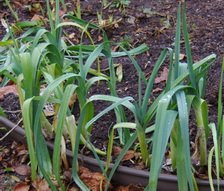 I have an abundance of Leeks still in the garden so it is time for one of my favourite ways of storing vegetables for the winter. A large pot of Leek soup will be on the stove early next week. It’s easy to make and can have a dozen variations depending on just what herbs or vegetables are available to go into the pot. Soup for lunch on a cold winter’s day is warming and nutritious and a great way to remember all of those wonderful summer days in the garden. Pea soup, squash soup, Red Pepper soup and many others can be made with the surplus produce from even the tiniest garden. Let’s not forget the baked beans made with all of the dried beans that we didn’t get time to pick when they were fresh green beans. I just collected some of them this week when I was taking down the trellis that supports the Pole Beans and Morning Glories. There are so many aspects to the gardening life that delight us in every season.
I have an abundance of Leeks still in the garden so it is time for one of my favourite ways of storing vegetables for the winter. A large pot of Leek soup will be on the stove early next week. It’s easy to make and can have a dozen variations depending on just what herbs or vegetables are available to go into the pot. Soup for lunch on a cold winter’s day is warming and nutritious and a great way to remember all of those wonderful summer days in the garden. Pea soup, squash soup, Red Pepper soup and many others can be made with the surplus produce from even the tiniest garden. Let’s not forget the baked beans made with all of the dried beans that we didn’t get time to pick when they were fresh green beans. I just collected some of them this week when I was taking down the trellis that supports the Pole Beans and Morning Glories. There are so many aspects to the gardening life that delight us in every season.Time to answer a few questions. If you have a gardening question just ‘reply’ to this newsletter and send me your query. I try to answer most of the questions and the ones that I answer here are those that I think will have the widest interest. You can also find the latest garden updates on the front page of gardening-enjoyed.com. |
| Back to Back Issues Page |
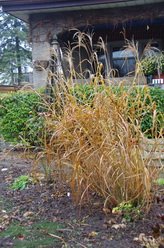 Meanwhile back at home, there are a myriad of undone tasks to get the garden ready for winter. I’m cutting off all the spent foliage from most of the perennials. I’m particularly fastidious about the Iris because the infamous
Meanwhile back at home, there are a myriad of undone tasks to get the garden ready for winter. I’m cutting off all the spent foliage from most of the perennials. I’m particularly fastidious about the Iris because the infamous